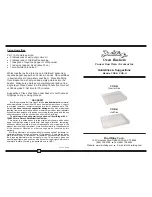
10
EN
Operating Instructions
Using Tow Bar
1. Unclip tow bar from stored position.
2. Remove pin, extend to proper length, insert pin and latch.
Failure to place safety latch over end of pin can
result in pin coming loose and can cause serious
injury to riders
3. Remove Quick Release from coupler end of tow bar.
4. Hold tow bar coupler end in one hand and lift front of child bike with other
hand. Slide coupler down over receiver, engaging them at curved
ears. Lower both tow bar and child bike, keeping upward force on child
bike, until fully engaged.
5. Insert Quick Release and lock.
6. Unclip stabilizer bar, pivot down and snap to front fork.
Storing Tow Bar
1. Unclip stabilizer bar from front fork by holding stabilizer bar with fingers
and pushing against fork with your thumb.
2. Pivot stabilizer bar up to stored position and clip.
3. Remove Quick Release from coupler and receiver.
4. Hold tow bar coupler end in one hand and child bike in other hand. Lift
both up, slightly pushing down on child bike until disengaged.
5. Insert Quick Release into coupler end of tow bar for storage.
Warning: Excessive clamping force may damage coupler by collapsing it.
6. Remove pin, slide tow bar together, insert pin and latch.
7. Fold tow bar down to side and place into storage clip.
Mechanical Safety Check
Carry out the following safety checks before every ride:
Tow Bar
- Ensure all nuts and bolts are properly tightened.
- Ensure all parts of tow bar have no damage or cracks.
- Ensure all moving parts in universal joint have no wear.
- Ensure safety pin and tow bar holes are not worn or damaged and
that they fit together without excessive play.
- Ensure coupler and receiver function properly and child bike is
positioned properly, facing forward when attached.
- Ensure Quick Release functions properly.
- Ensure handlebar stabilizer assembly functions properly.
- Ensure all storage clips function properly.
Adult Bike
- Ensure seat post is not bent or cracked and is securely fastened
into frame.
- Ensure front and rear brakes work properly.
- Ensure bike is in correct and safe working order. See adult bike
Owner’s Manual.
Child Bike
- Ensure head tube and frame of bike has no sign of damage.
- Ensure rear free wheel capability and brakes work properly.
- Ensure bike is in correct and safe working order. See child bike
Owner’s Manual.
Rider Safety Check
- Riders must wear properly fitted and approved bicycle helmets.
- Never use off-road. Use only on smooth surfaces.
- Never exceed maximum child rider weight of 70 pounds.
- Do not ride on highways, in traffic, or on unsafe streets.
- Never exceed 15 miles per hour using tow bar.
- Never ride over bumps or curbs using tow bar.
- Avoid cornering near objects. Child bike will track closer to objects
than adult bike.
- Never carry more than one child on child bike.
- Never use tow bar with a motorized bicycle or vehicle.
- Never use tow bar while carrying another child on adult bike.
- Adult rider must be thoroughly familiar with all operations and controls (steering,
braking, and gears) of adult bike before using tow bar.
- You must allow for greater starting and stopping distances due to
extra length and weight of child rider and child bike.
- Adult rider must steady and securely hold adult bike upright before
allowing child to mount child bike.
- Never use when child is tired. Child must be alert and capable of staying seated,
keeping hands on handlebars and feet on pedals at all times.
- Adult and child rider must wear shoes that are securely fastened
onto feet and that provide an adequate grip to pedals. Never ride
barefoot or with sandals.
- Riding at night is dangerous and should be avoided. Only ride at night with appro-
ved lighted system and correctly positioned
reflectors on both bikes.
- The child should have warmer clothes than the rider and it needs rain
protection.
Riding With Tow Bar
Locate a safe, flat, and level riding area with no traffic to become safely fami-
liar with operation and feel of towing the child bike. First, attach tow bar and ride
without towing a child on the child bike. Note how both bikes turn, lean and feel
while riding, stopping and starting. Note how child bike tracks closer when turning
than adult bike and requires a wider turn, when close to objects, in order to clear
objects. Continue to ride with child bike unoccupied until you feel confident with
your ability to safely operate stopping, starting and towing the child bike.
Still in a safe area away from traffic, hold adult bike in upright position and allow
child to mount child bike. You must always hold child bike steady when child gets
on. Begin riding with the child at a slow pace and continue to ride until you are
confident of both your abilities and the child’s abilities to safely operate each bike
with tow bar attached.
Practice starting and stopping. Distances required will be much different than
when you are riding alone. You must allow for extra weight and length when stop-
ping and starting. Learn and understand these differences before attempting to
use tow bar in general riding situations. It is important to teach the child to use
brakes only when instructed before attempting general riding situations.
Once you are confident of your abilities and the child’s abilities to safely use
tow bar you can then use it for more general riding situations. Never use tow bar if
you have any doubts about your ability or the child’s ability to handle general riding
situations
Do not leave your child unattended!











































